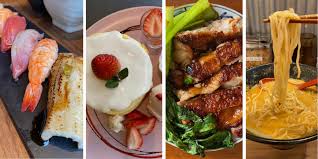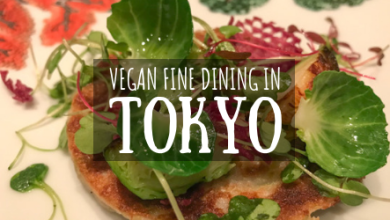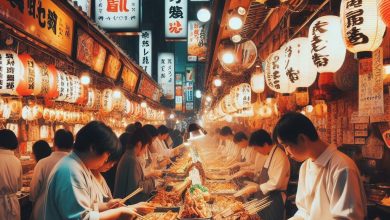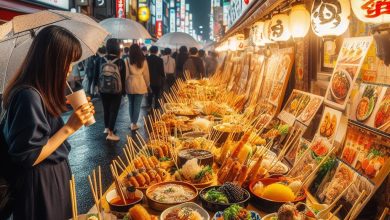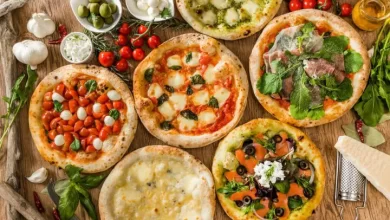Culinary Wonders of Tokyo: A Gastronomic Journey Through Japan’s Capital
A Gastronomic Journey Through Japan's Capital
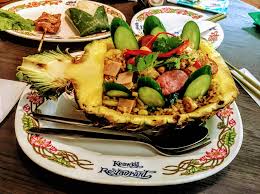
Introduction:
Tokyo is a thriving metropolis that skillfully combines modern and traditional elements. It is a global center for fashion, technology, and food. Tokyo cuisine offers a symphony of flavors, textures, and aesthetics that represent the city’s rich history and cultural variety. It is a gastronomic voyage that goes beyond simple nourishment. Tokyo’s food culture is examined in this article, along with its varied offers, distinctive eating experiences, and the cultural significance of its culinary environment.
Diversity of Cuisine:
Tokyo offers a diverse range of gastronomic experiences, from well prepared traditional Japanese fare to cutting-edge foreign food. The city is home to an incredible variety of eating establishments, including as busy food markets, izakayas (traditional Japanese bars), street food vendors, and Michelin-starred restaurants.
- Sushi and Sashimi: Tokyo is known for its delicious sushi and sashimi, which form the core of its culinary identity. Seafood is of the highest caliber and freshest when it is served in the famous Tsukiji Fish Market or in traditional sushiya (sushi restaurants). Sushi chefs turn the freshest fish cuts into delicious, bite-sized masterpieces, showcasing their dexterity and artistic talent.
- Ramen: With its wide selection of types and broths, Tokyo is a ramen lover’s dream come true. Every bowl of ramen, from the silky smooth tonkotsu to the lighter shoyu (soy sauce) and shio (salt) variants, narrates a tale of local influences and skillful cooking. Locals and tourists alike are drawn to popular ramen neighborhoods like Ikebukuro and Shibuya.
- Kaiseki: Kaiseki food calls to those looking for a more sophisticated dining experience. Kaiseki dinners are multi-course experiences that showcase the chef’s talent and inventiveness, and they are based on the concepts of seasonality and presentation. These elegant dining encounters provide a profound understanding of Japanese culinary craftsmanship by showcasing the balance of flavors and textures.
Culinary Innovation and Fusion:
Tokyo’s food culture is marked by a spirit of creativity and openness to outside ideas, even though it is deeply steeped in history. The city acts as a crossroads for world cuisine, where cooks experiment with tastes and methods to create a vibrant and changing culinary scene.


- Izakayas with a Twist: Tokyo’s izakayas, or traditional drinking places, have welcomed innovation without sacrificing their friendly vibe. Contemporary izakayas could provide fusion cuisine, fusing flavors from Japan with ingredients from across the world to create a special and unforgettable eating experience.
- Kawaii Culture and Character Cafés: There are a tonne of themed cafés in Tokyo, from animal-themed establishments to ones with manga and anime influences. In addition to providing delicious sweets, these cafés transport guests to the adorable and whimsical realm of kawaii (cuteness) through a sensory experience.cosmopolitan character.
Unique Dining Experiences:
Tokyo’s distinctive eating experiences, in addition to its superb flavors, add to the city’s gastronomic appeal. These experiences, which range from omakase (chef’s choice) counters to themed restaurants, add levels of depth to the culinary adventure.
- Robot Restaurant: The Robot Restaurant, located in the center of Shinjuku, is a sensory extravaganza of futuristic robots, neon lights, and upbeat performances. Tokyo has managed to successfully combine dining and entertainment, even though the experience is more memorable for the show than the cuisine.
- Omoide Yokocho (Memory Lane): Omoide Yokocho, or Memory Lane, is a little lane dotted with izakayas and tiny yakitori restaurants, tucked away in the shadows of Shinjuku. The small-scale atmosphere, complete with smoke-filled air and lantern-lit stalls, takes diners back in time and gives them a nostalgic flavor of ancient Tokyo.
Cultural Significance:
Tokyo cuisine reflects social customs, cultural values, and traditions in addition to providing nourishment. In Tokyo, eating is a social activity that emphasizes peace, deference to food, and a respect for the passing of time.
- Seasonal Sensibilities: Tokyo’s cuisine, like that of Japan, strongly emphasizes seasonality. Seasonal variations in menus highlight products at the height of their freshness. In addition to enhancing tastes, this devotion to seasonality links diners to the natural cycles of the surroundings.
- Respect for Ingredients: The core value of Japanese cuisine is a deep regard for ingredients. From carefully slicing sashimi to creatively assembling kaiseki dishes, Tokyo chefs always demonstrate their commitment to showcasing the inherent qualities of every ingredient.

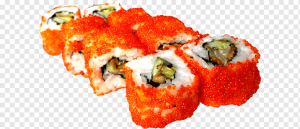
Conclusion:
To sum up, Tokyo cuisine is a culinary adventure that goes beyond just eating. It’s a colorful tapestry made from creativity, tradition, and a strong cultural bond with food. Tokyo provides a varied and enthralling gastronomic experience that reflects the city’s vibrancy and cosmopolitan culture, from the modest street vendors to the Michelin-starred restaurants. Tokyo’s gastronomic offerings leave a lasting impression on the palates and memories of those who are lucky enough to partake in them. Tokyo’s culinary wonders are not simply a feast for the senses but also a deep investigation of Japanese culture and history.

